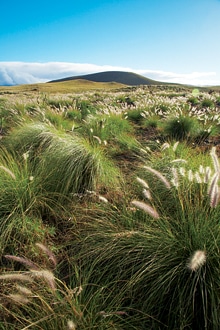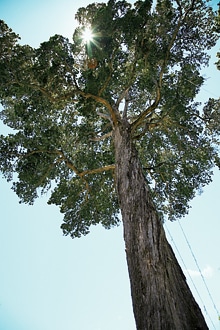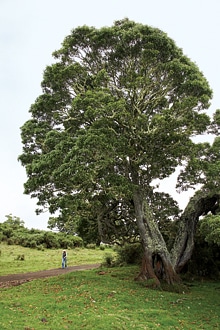Blue List: Eco-Adventures
What Are Eco-Adventures? They're about getting out in the wild, but they're also about respecting and protecting Mother Nature. Many companies offer eco-tours, but not every company invests time, energy and money into keeping the places they tour environmentally healthy, supporting and working together with the people who live there, and integrating the local culture. When you choose one that does, you walk away with not only bragging rights about a thrilling adventure, but you also help keep the wild wild.
Driving along a dirt road on the saddle land between Mauna Kea and Mauna Loa, Rob Pacheco of Hawaii Forest & Trail takes his left hand off the wheel to point out a pair of nene geese on the wing. Rob's right hand already hovers over the dashboard, indicating a whole hillside covered in an invasive plant called gorse.
Beneath the distinctive black-headed birds, colonies of dark-green 'ohi'a lehua trees grow amid vast basalt lava flows. Rob traces the birds' north- westward flight path, probably from the Nene Sanctuary to Hakalau Forest, where we're headed for a bird-watching hike. I'm no birder. At home in Florida, I can distinguish a wading bird from other birds by the water around its ankles. But I'm eager to enter one of the few preserved remnants of native forest — and take an amazing walk on Hawaii's true wild side.
Rob had started pointing out plants, animals and geological features as soon as we got in the truck. His hands move constantly, illustrating the land- scape as he narrates our progress through it — ring-necked pheasants foraging on the right, an Erckel's francolin scooting into the scrub on the left.
Gorse came from western Europe, he tells me, and without the species that co-evolved there to keep it in check, it runs rampant in Hawaii, choking out native plants and grasses introduced to feed cattle. We stop to look at gorse up close, an evil-looking shrub almost all thorn. Tales of introduced species — super-adaptable finches afflicted with mosquitoes, delicious but aggressive guavas crowding out maile vines — accompany every nature tour in Hawaii. "You don't often see that," Rob interrupts himself when he spots the airborne geese. "A lot of people are surprised to learn the nene can fly."
I've done other eco-adventures on the Big Island. Bottom Time Hawaii took me to see manta rays feeding on light-baited plankton off the Kona coast. Mauna Kea Summit Adventures drove me up the mountain for an amazing sunset and stargazing. Well-run and offering impressive sights, these higher-volume excursions present nature as spectacle — a manta soaring through the white light of a hundred dive torches, the sun subsiding through a hundred shades of orange. It's possible to enjoy these trips for their scenic splendor alone. Background information embellishes the experience, but raw visuals draw the crowds.

By contrast, before we even park at the maintenance barn that serves as the Hakalau trailhead, my mind is churning, trying to assimilate a story obviously too complicated to tell from the beginning. Nature has no beginning, I'm learning, no single thread. It's all parallels and intersections. But starting in the middle, Rob makes clear we're seeing something rare. I feel less like a tourist and more like a witness. Behold: Hawaii.
That subtle distinction generates eco-adventure's key attraction, reflected in the admittedly hyperbolic language of both eco-travel and conservation: Nowhere else on earth! See endemic species before they're gone! And cautionary statistics function as enticements: Extinctions daily! Book now! But within the hype, ecology is fascinating. The mechanisms of adaptation, the improbable symbioses — plus the violence, Tennyson's "nature, red in tooth and claw" — make engaging, life-or-death narrative. What happens next?
We lace our boots and finally walk through a pig fence and down into the forest. As we descend along the rutted two-track road, Rob picks out individual birdcalls from the scattering of tweets, chirps and trills. "'Elepaio," he says, waving up the hill, "and 'akepa," waving down the hill. He's so good at this, he can tell a bird's call from another bird mimicking its call. He points out adolescent koa trees, the sprays of horizontal juvenile leaves flattening at the stem into the vertical, sickle-shaped leaves of the adult tree. He points out a larger fallen koa that has become a nurse log to a neat row of new trees, with understory plants sheltering beneath.
Without leaving the trail, Rob scoops an inch-worm off a strand of silk. We look at it under a hand lens, its pincers grasping at air. "The first carnivorous caterpillar ever discovered," he says. "Most caterpillars eat leaves. These started eating fruit flies in an adaptive shift." Find an unevolved fly in an unoccupied niche and bite off its itty-bitty head.
In a stand of 'ohi'a lehua, birds flit in and out among the branches. Here Rob teaches me the technique for sighting birds. Spot a bird with the naked eye, then keep the head still to avoid losing sight of it as you bring the binoculars up. I get on an 'i'iwi, the scarlet honeycreeper. As the finch-size bird jumps into focus — bright red body and curved black bill, icon of natural Hawaii — I say, "Wow!"

Looking at a picture in a field guide earlier, Rob had said the threatened bird's beak and coloring evolved to match the shape and shade of the 'ohi'a blossom, the lehua. The bird cross-pollinates the trees as it feeds on their nectar. He tells the creature's story, a sort of conjuring. And then there it is.
If we can call spectacle the first stage of eco-consciousness — wonders of the natural world, giant fish and jaw-dropping sunsets — then Rob Pacheco guides people to the second stage, the connection behind those wonders. He connects the way an elepaio finds insects to the way ancient canoe builders once found the soundest trees. And connections may carry us to the third stage, stewardship, the effort to sustain nature and thereby sustain ourselves.
In it for profit, Rob understands that spectacle and stewardship reinforce each other. "I could make three times as much money," he says at one point, standing in an Edenic glade, "if there were a waterfall right here." He also understands his livelihood depends on maintaining Hawaii as close as possible to its natural state. His company donates money, vehicles and employee time to conservation projects. He even gets guests to pull invasive kahili ginger from a plot in Volcanoes National Park.
A hundred meters off the trail in what feels like primeval woods, I spot an iridescent orange bird. "'Akepa," Rob says before I even point — and I say, "Wow," again, pointing anyway. Previous to this adventure, I didn't care much about one orange bird, give or take. But out here with someone who cares a lot, I care too. Rob never says, "We must preserve this." He doesn't have to. As we walk through kikuyu grass beneath 500-year-old koa trees, as the cacophony of birdcalls resolves into symphony, the necessity of Hawaii resounds. hawaii-forest.com
Eco-Adventures: More Winners In addition to our featured trip detailed above, ISLANDS recommends these trips from our 2009 Blue List, which also represent the best in sustainable travel.
Rinjani Trek, Lombok Islands, IndonesiaDepending on exactly how adventurous a trekker you are, you can pick among five levels of difficulty to explore the volcanic Mount Rinjani, part of the Pacific's "Ring of Fire." Use no fossil fuels, just your own power, to rise up through tropical forest and reach the crater rim at 8,700 feet. It's minimal environmental impact with maximum access. rinjaninationalpark.com
Bush and Beyond's Heaphy Track Trip, South Island, New ZealandGo for a 50-mile walk over five days to see both the ecological history and current beauty of New Zealand. Truly stop & smell the dendrobium orchids, as the fourth day's itinerary only covers five miles. Finish on the coast of the Tasman Sea and see what are billed as the world's most southern palm trees. naturetreks.co.nz
Lindblad Expeditions, Galápagos IslandsWith the approval of Galápagos National Park, the expedition route hopscotches between islands and offers activities such as Zodiac cruising, kayaking and snorkeling. On-hand naturalists with expertise about life above and below the sea help you find the wonders you can see without being intrusive. Travelers can join in Lindblad's conservation efforts, which have raised $5 million for the islands to date. expeditions.com
Cockpit Country Adventure Tours and Homestays, JamaicaGo beyond the beach resorts and into Cockpit Country. The Southern Trelawny Environmental Agency runs tours through the limestone forests of Jamaica's biggest wilderness area. Local families open their homes, offering a bed- and-breakfast-style stay for an experience few travelers can match. stea.net
Ireland Ecotours, Ireland A selling point of these Emerald Island tours is that you drive around in what's called "Ireland's first veggie-oil eco- bus." The biofuel, from locally grown rapeseed crops, promises to be carbon neutral. So as you follow the route for up to eight days from Dublin to the Wilds of Mayo to the Giants Causeway, you'll also be following the tour company's "Leave No Trace" philosophy. irelandecotours.com
